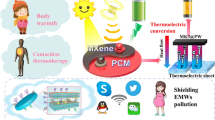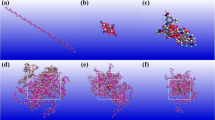Abstract
In this study, immiscible polypropylene/poly(butylene succinate) (PP/PBS) blend-based nanocomposites were successfully prepared using an internal mixer. Carbon nanotube (CNT)/organo-montmorillonite (15A) and maleated PP (PPgMA) served as the reinforcing nanofillers and compatibilizer, respectively. Scanning electron microscopy results showed that PPgMA played an efficient role as compatibilizer for reducing the dispersed domain size of PBS in the blend. The added CNT was randomly distributed within the PP and PBS phases, whereas 15A was selectively located in the PBS domain. Differential scanning calorimetry results confirmed the nucleation effect of CNT on the PP/PBS crystallization, but 15A addition only facilitated the PBS crystallization. Thermogravimetric analysis revealed that CNT and 15A both enhanced the thermal stability of the blend under air environment. The rheological property measurements confirmed the significant change in microstructure of composites through developing the pseudo-network structure with CNT and/or 15A additions. The Young’s modulus (YM) of PP/PBS blend increased evidently with the inclusion of CNT. The incorporation of 2.5 phr CNT evidently increased the YM by approximately 243% compared with that of neat PBS. The electrical resistivity of the samples drastically reduced with the addition of CNT up to 10 orders of drop at a 3-phr CNT loading. The electrical percolation was constructed at a CNT content of 0.5 phr.









Similar content being viewed by others
References
Scott G (2000) ‘Green’ polymers Polym Degrad Stab 68(1):1–7
Lenz RW, Marchessault RH (2005) Bacterial polyesters: biosynthesis, biodegradable plastics and biotechnology Biomacromolecules 6(1):1–8
Arias A, Sojoudiasli H, Heuzey MC, Huneault MA, Wood-Adams P (2017) Rheological study of crystallization behavior of polylactide and its flax fiber composites J Polym Res 24(3):46 (10 pp)
Manavitehrani I, Fathi A, Badr H, Daly S, Negahi Shirazi A, Dehghani F (2016) Biomedical applications of biodegradable polyesters Polymer 8(1):20 (32 pp)
Panaitescu DM, Nicolae CA, Frone AN, Chiulan I, Stanescu PO, Draghici C, Iorga M, Mihailescu M (2017) Plasticized poly(3-hydroxybutyrate) with improved melt processing and balanced properties J Appl Polym Sci 134(19):44810 (14 pp)
Lai SM, Liu YH, Huang CT, Don TM (2017) Miscibility and toughness improvement of poly(lactic acid)/poly(3-Hydroxybutyrate) blends using a melt-induced degradation approach J Polym Res 24(7):102 (12 pp)
Vytejčková S, Vápenka L, Hradecký J, Dobiáš J, Hajšlová J, Loriot C, Vannini L, Poustka J (2017) Testing of polybutylene succinate based films for poultry meat packaging Polym Test 60:357–364
Kanemura C, Nakashima S, Hotta A (2012) Mechanical properties and chemical structures of biodegradable poly(butylene-succinate) for material reprocessing Polym Degrad Stab 97(6):972–980
Shih YF, Chen LS, Jeng RJ (2008) Preparation and properties of biodegradable PBS/multi-walled carbon nanotube nanocomposites Polymer 49(21):4602–4611
Wang X, Huang S, Wang Y, Wei P, Chen Y, Xia Y, Wang Y (2017) Eco-friendly cellulose acetate butyrate/poly(butylene succinate) blends: crystallization, miscibility, thermostability, rheological and mechanical properties J Polym Res 24(2):16 (9 pp)
Zeng RT, Hu W, Wang M, Zhang SD, Zeng JB (2016) Morphology, rheological and crystallization behavior in non-covalently functionalized carbon nanotube reinforced poly(butylene succinate) nanocomposites with low percolation threshold Polym Test 50:182–190
Lai SM, Kao YH, Liu YK, Chiu FC (2016) Preparation and properties of luffa fiber- and kenaf fiber-filled poly(butylene succinate-co-lactate)/starch blend-based biocomposites Polym Test 50:191–199
Roder H, Vogl O (1999) 17th international Herman F. Mark symposium: polypropylene-a material of the future Prog Polym Sci 24(8):1205–1215
Oliani WL, Parra DF, Komatsu LGH, Lincopan N, Rangari VK, Lugao AB (2017) Fabrication of polypropylene/silver nanocomposites for biocidal applications Mater Sci Eng C 75:845–853
Chen WM, Yang MC, Hong SG, Hsieh YS (2017) Effect of poly(styrene-co-maleic anhydride) on physical properties and crystalline behavior of nylon-6/PEBA blends J Polym Res 24(3):40 (8 pp)
Zhu N, Ye M, Shi D, Chen M (2017) Reactive compatibilization of biodegradable poly(butylene succinate)/spirulina microalgae composites Macromol Res 25(2):165–171
Chiu FC (2017) Halloysite nanotube-and organoclay-filled biodegradable poly (butylene succinate-co-adipate)/maleated polyethylene blend-based nanocomposites with enhanced rigidity Compos Part B Eng 110:193–203
Andrews R, Jacques D, Qian D, Rantell T (2002) Multiwall carbon nanotubes: synthesis and application Acc Chem Res 35(12):1008–1017
Chiu FC, Yeh SC (2015) Comparison of PVDF/MWNT, PMMA/MWNT, and PVDF/PMMA/MWNT nanocomposites: MWNT dispersibility and thermal and rheological properties Polym Test 45:114–123
Lin ZI, Lou CW, Pan YJ, Hsieh CT, Huang CL, Huang CH, Chen YS, Lin JH (2017) The effects of MWCNT length on the mechanical, crystallization and electromagnetic interference shielding effectiveness of PP/MWCNT composites J Polym Res 24(2):32 (11 pp)
Hwang TY, Yoo Y, Lee JW (2012) Electrical conductivity, phase behavior, and rheology of polypropylene/polystyrene blends with multi-walled carbon nanotube Rheol Acta 51(7):623–636
Chiu FC (2014) Comparisons of phase morphology and physical properties of PVDF nanocomposites filled with organoclay and/or multi-walled carbon nanotubes Mater Chem Phys 143(2):681–692
Sinha Ray S, Bandyopadhyay J, Bousmina M (2007) Effect of organoclay on the morphology and properties of poly(propylene)/poly[(butylene succinate)-co-adipate] blends Macromol Mater Eng 292(6):729–747
Gcwabaza T, Ray SS, Focke WW, Maity A (2009) Morphology and properties of nanostructured materials based on polypropylene/poly (butylene succinate) blend and organoclay Eur Polym J 45(2):353–367
Bouakaz BS, Habi A, Grohens Y, Pillin I (2017) Organomontmorillonite/graphene-PLA/PCL nanofilled blends: new strategy to enhance the functional properties of PLA/PCL blend Appl Clay Sci 139:81–91
Chiu FC, Chu PH (2006) Characterization of solution-mixed polypropylene/clay nanocomposites without compatibilizers J Polym Res 13(1):73–78
Chiu FC, Lee CE, Lo CT (2013) Fabrication and comparison of PP (blend)-based (nano) composites-effect of PP matrix flow property Mater Chem Phys 139(2):580–589
Yadav YS, Jain PC (1986) Melting behaviour of isotactic polypropylene isothermally crystallized from the melt Polymer 27(5):721–727
Fenoglio I, Tomatis M, Lison D, Muller J, Fonseca A, Nagy JB, Fubini B (2006) Reactivity of carbon nanotubes: free radical generation or scavenging activity? Free Radic Biol Med 40(7):1227–1233
Chu CC, White KL, Liu P, Zhang X, Sue HJ (2012) Electrical conductivity and thermal stability of polypropylene containing well-dispersed multi-walled carbon nanotubes disentangled with exfoliated nanoplatelets Carbon 50(12):4711–4721
Acknowledgements
The authors thank the Chang Gung Memorial Hospital (Taiwan) for financially supporting this research under contract CMRPD2F0141.
Author information
Authors and Affiliations
Corresponding author
Rights and permissions
About this article
Cite this article
Sivanjineyulu, V., Chang, YH. & Chiu, FC. Characterization of carbon nanotube- and organoclay-filled polypropylene/poly(butylene succinate) blend-based nanocomposites with enhanced rigidity and electrical conductivity. J Polym Res 24, 130 (2017). https://doi.org/10.1007/s10965-017-1289-1
Received:
Accepted:
Published:
DOI: https://doi.org/10.1007/s10965-017-1289-1




